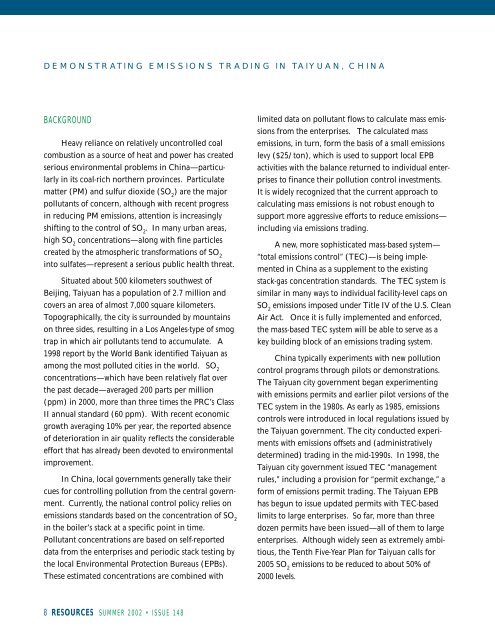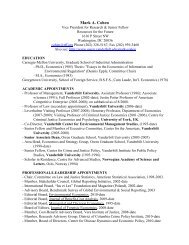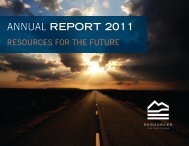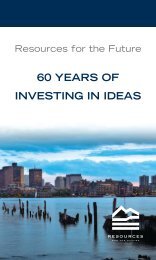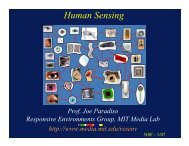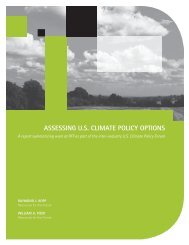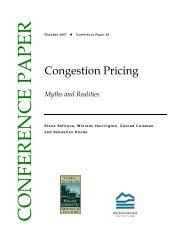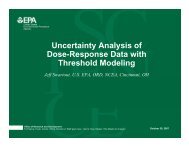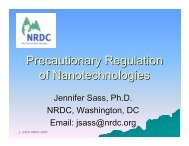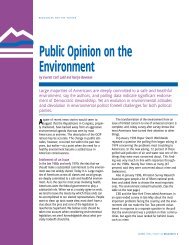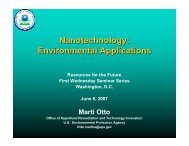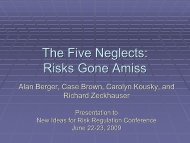Resources: Summer 2002; Issue 148 - Resources for the Future
Resources: Summer 2002; Issue 148 - Resources for the Future
Resources: Summer 2002; Issue 148 - Resources for the Future
Create successful ePaper yourself
Turn your PDF publications into a flip-book with our unique Google optimized e-Paper software.
DEMONSTRATING EMISSIONS TRADING IN TAIYUAN, CHINA<br />
BACKGROUND<br />
Heavy reliance on relatively uncontrolled coal<br />
combustion as a source of heat and power has created<br />
serious environmental problems in China—particularly<br />
in its coal-rich nor<strong>the</strong>rn provinces. Particulate<br />
matter (PM) and sulfur dioxide (SO 2<br />
) are <strong>the</strong> major<br />
pollutants of concern, although with recent progress<br />
in reducing PM emissions, attention is increasingly<br />
shifting to <strong>the</strong> control of SO 2<br />
. In many urban areas,<br />
high SO 2<br />
concentrations—along with fine particles<br />
created by <strong>the</strong> atmospheric trans<strong>for</strong>mations of SO 2<br />
into sulfates—represent a serious public health threat.<br />
Situated about 500 kilometers southwest of<br />
Beijing, Taiyuan has a population of 2.7 million and<br />
covers an area of almost 7,000 square kilometers.<br />
Topographically, <strong>the</strong> city is surrounded by mountains<br />
on three sides, resulting in a Los Angeles-type of smog<br />
trap in which air pollutants tend to accumulate. A<br />
1998 report by <strong>the</strong> World Bank identified Taiyuan as<br />
among <strong>the</strong> most polluted cities in <strong>the</strong> world. SO 2<br />
concentrations—which have been relatively flat over<br />
<strong>the</strong> past decade—averaged 200 parts per million<br />
(ppm) in 2000, more than three times <strong>the</strong> PRC’s Class<br />
II annual standard (60 ppm). With recent economic<br />
growth averaging 10% per year, <strong>the</strong> reported absence<br />
of deterioration in air quality reflects <strong>the</strong> considerable<br />
ef<strong>for</strong>t that has already been devoted to environmental<br />
improvement.<br />
In China, local governments generally take <strong>the</strong>ir<br />
cues <strong>for</strong> controlling pollution from <strong>the</strong> central government.<br />
Currently, <strong>the</strong> national control policy relies on<br />
emissions standards based on <strong>the</strong> concentration of SO 2<br />
in <strong>the</strong> boiler’s stack at a specific point in time.<br />
Pollutant concentrations are based on self-reported<br />
data from <strong>the</strong> enterprises and periodic stack testing by<br />
<strong>the</strong> local Environmental Protection Bureaus (EPBs).<br />
These estimated concentrations are combined with<br />
limited data on pollutant flows to calculate mass emissions<br />
from <strong>the</strong> enterprises. The calculated mass<br />
emissions, in turn, <strong>for</strong>m <strong>the</strong> basis of a small emissions<br />
levy ($25/ton), which is used to support local EPB<br />
activities with <strong>the</strong> balance returned to individual enterprises<br />
to finance <strong>the</strong>ir pollution control investments.<br />
It is widely recognized that <strong>the</strong> current approach to<br />
calculating mass emissions is not robust enough to<br />
support more aggressive ef<strong>for</strong>ts to reduce emissions—<br />
including via emissions trading.<br />
A new, more sophisticated mass-based system—<br />
“total emissions control” (TEC)—is being implemented<br />
in China as a supplement to <strong>the</strong> existing<br />
stack-gas concentration standards. The TEC system is<br />
similar in many ways to individual facility-level caps on<br />
SO 2<br />
emissions imposed under Title IV of <strong>the</strong> U.S. Clean<br />
Air Act. Once it is fully implemented and en<strong>for</strong>ced,<br />
<strong>the</strong> mass-based TEC system will be able to serve as a<br />
key building block of an emissions trading system.<br />
China typically experiments with new pollution<br />
control programs through pilots or demonstrations.<br />
The Taiyuan city government began experimenting<br />
with emissions permits and earlier pilot versions of <strong>the</strong><br />
TEC system in <strong>the</strong> 1980s. As early as 1985, emissions<br />
controls were introduced in local regulations issued by<br />
<strong>the</strong> Taiyuan government. The city conducted experiments<br />
with emissions offsets and (administratively<br />
determined) trading in <strong>the</strong> mid-1990s. In 1998, <strong>the</strong><br />
Taiyuan city government issued TEC “management<br />
rules,” including a provision <strong>for</strong> “permit exchange,” a<br />
<strong>for</strong>m of emissions permit trading. The Taiyuan EPB<br />
has begun to issue updated permits with TEC-based<br />
limits to large enterprises. So far, more than three<br />
dozen permits have been issued—all of <strong>the</strong>m to large<br />
enterprises. Although widely seen as extremely ambitious,<br />
<strong>the</strong> Tenth Five-Year Plan <strong>for</strong> Taiyuan calls <strong>for</strong><br />
2005 SO 2<br />
emissions to be reduced to about 50% of<br />
2000 levels.<br />
8 RESOURCES SUMMER <strong>2002</strong> • ISSUE <strong>148</strong>


